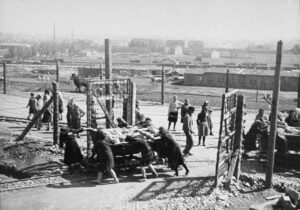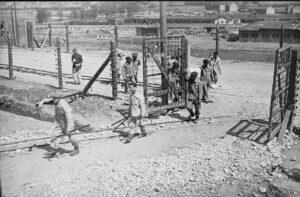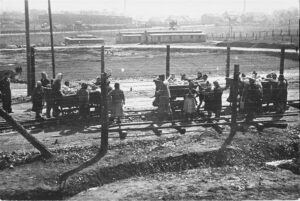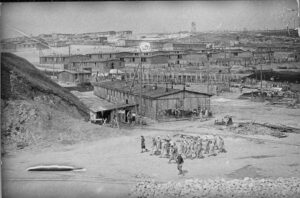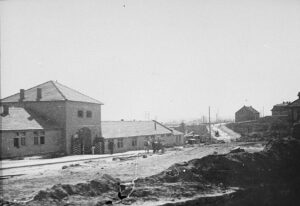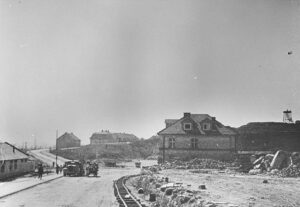Perpetrator Spaces of Oppression and Victim Spaces of Experience: KL Płaszów
Nazi domination of Kraków led to a brutal combination of ideological ambition for a “Germanized” east, specific racist policies that targeted Jewish and other populations, and a massive coordination of the raw materials and (forced) labor of the military economy. This section covers work that especially addresses how buildings resulted from or were instrumental to the implementation of perpetrator policies in Kraków. It specifically focuses on forced labor and the integration of Kraków into the system of oppression and economic exploitation central to the German war effort and concomitant genocidal project.
Płaszów during the War (Madritsch factory workshops)
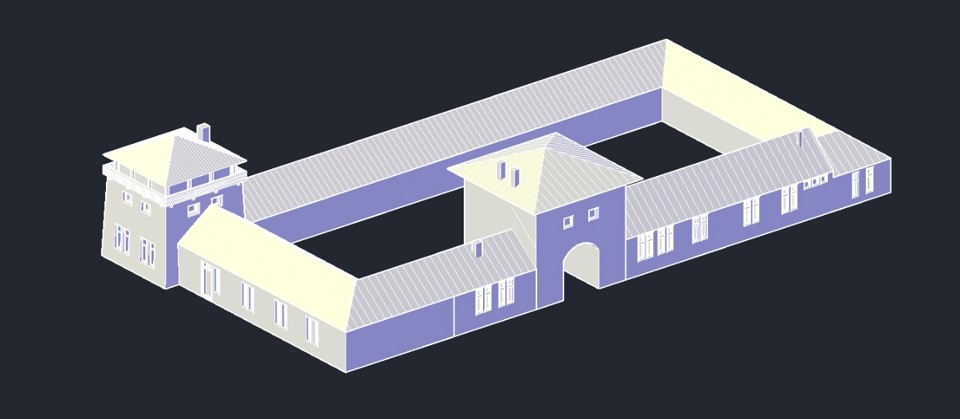
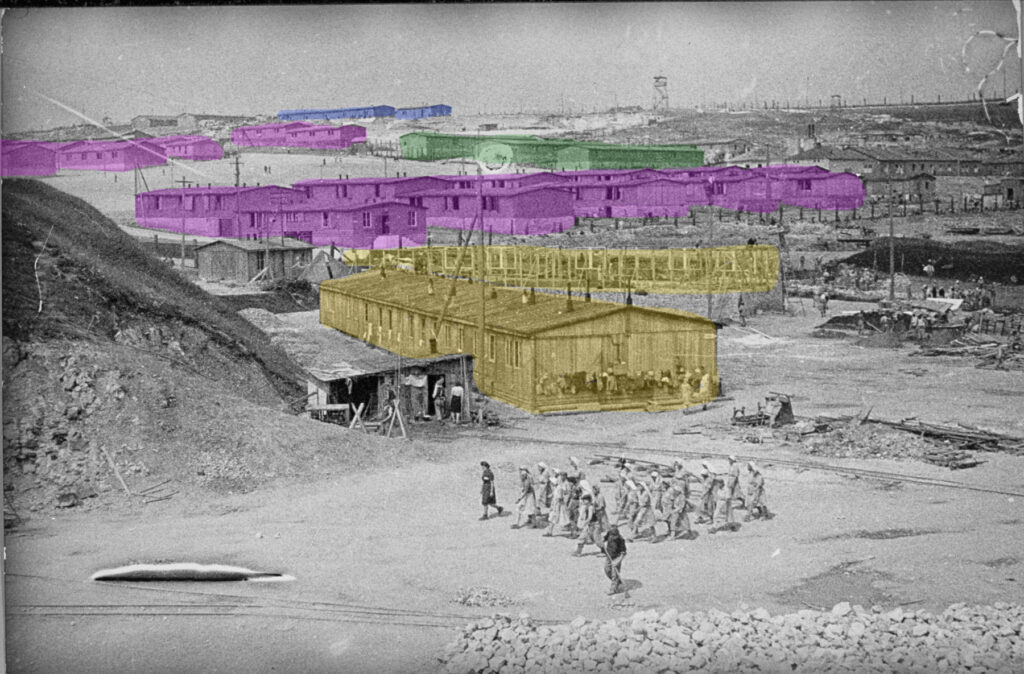
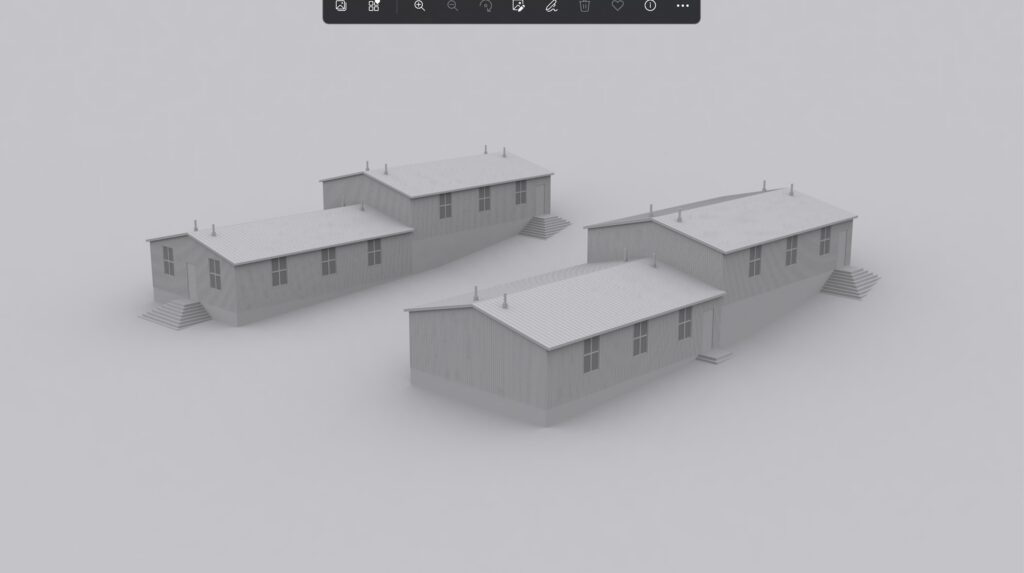
The US Holocaust Memorial Museum Photo Archive features a collection of photographs of KL Plaszow from 1943-1944. The SS established KL Plaszow south of the Vistula in Krakow for the punishment and suppression of Polish Jews and others deemed racially, ideologically, or politically a threat to the Nazi “Germanification” of the General Government. Not only do the photographs give insight to building details and labor tasks within the concentration camp, but they also serve as a possible means to communicate resistance to the Nazi occupation and SS brutality for the photographer, Raimund Titsch, and his associate and factory owner, Julius Madritsch.
Raimund Titsch was assistant manager to Madritsch in the latter’s textile factories located on the south end of the concentration camp.
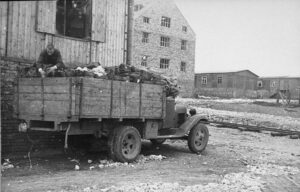
Photo number 03041 captures a building with a brick foundation and a wood shaft in the foreground that belonged to a collection of Madritsch factory workshops. The background of the photograph displays a glimpse of a massive brick warehouse accompanied by two rows of barracks. In the image, Jewish prisoners are handling fabric materials piled in the back end of the truck. Madritsch and Titsch employed prisoners of Krakow in 1941 and later Plaszow in 1943 when the Krakow ghetto was liquidated. They aided Jewish men and women by giving them humane working conditions, extra food rations, and assisting their escape from the concentration camp bounds.
As far as we know, Raimund Titsch didn’t record exact dates for the collection of photographs, only approximate years (the photographs were developed only after the war). Despite not having this piece of information, the available photographs are restricted to certain areas of the concentration camp. When the photographs are placed in a specific order, one can see that Titsch took them as he walked a specific path through the camp.
Photo numbers 50709, 05269 , and 77597 among several others appear to be taken consecutively while Titsch remained in place. They capture an eastward view of the concentration camp with Jewish men and women performing forced labor. Prisoners gather near the railroad to push carts that are just beyond the barbed wire in the foreground of all of the photographs. The railroad leads to an opening in the barbed wire that would eventually trail along the factory row that occupied the southwest section of the concentration camp. A majority of Titsch’s photographs remain near the Madritsch factory, yet they still extend to far reaches of the camp. This permits the viewer to see administrative buildings and construction sites in the background but also understand the limits of Titsch’s ability to traverse the site at will.
Despite the similarities among many of the photographs, one image distinct from the rest of the Titsch collection is photo number 32058. Rather than frame forced labor near factory barracks row, this photograph covers the vast Appelplatz (roll call plaza) north of center of the concentration camp. Rows of barracks line the back of the Appelplatz, and active construction sites can be seen sporadically across the viewshed. A cluster of Jewish women can be seen walking in the center of the Appelplatz. This photograph stands alone as the only one facing this section of the camp.
Outside of prisoner spaces, Titsch was able to photograph administrative sections of the camp. Photo numbers 03393 and 03406 are located at a northern entrance to the concentration camp. Titsch seems to be stationary while capturing this section of the concentration camp, and similar to the photographs near factory row, one might notice a panorama when several photographs of the administrative building are placed next to each other. In these images, there is a forked road surrounded by two-story S.S. buildings. Despite their sturdy structural distinction from the barracks and factory buildings, construction materials and mounds of soil still border the road. Clearly, the concentration camp was not fully completed or established during the time (c. Late 1943) that most of these photographs were taken.
Raimund Titsch’s reasoning for photographing the forced labor in KL Plaszow is unclear, but it does align well with the Madritsch-Titsch mission to oppose violent, militaristic forces that the Nazis upheld. They did this by working within the system and maintaining a facade of “Nazism.” Simply the action of photographing may not have been suspicious to an S.S. officer, yet it is a firm act of defiance against the Nazi agenda. Titsch and Madritsch’s discrete protest is precisely what allowed them to function in favor of Jewish prisoners within Krakow and Plaszow for as long as they did. They were both subsequently declared “Righteous Among the Nation” by Yad Vashem.
Sources Used
David M. Crowe, Oskar Schindler: The Untold Account of His Life, Wartime Activities, and the True Story Behind the List (Basic Books, 2007).
Martin Gilbert, The Righteous: The Unsung Heroes of the Holocaust (Henry Holt, 2004).
Dieter Pohl, “Krakau-Plaszow Main Camp,” in Geoffrey P. Megargee, The United States Holocaust Memorial Museum Encyclopedia of the Camps and Ghettos, 1933-1945, Vol. I (Bloomington: Indiana University Press, 2009), 862-66.
Yad Vashem, “Julius Madritsch and Raimund Titsch,” (Jerusalem), https://www.yadvashem.org/yv/pdf-drupal/en/education/jewish_world/righteous-3.pdf (Accessed 18 March 2022).
Entry Author: Sadie Sheridan (2022)
